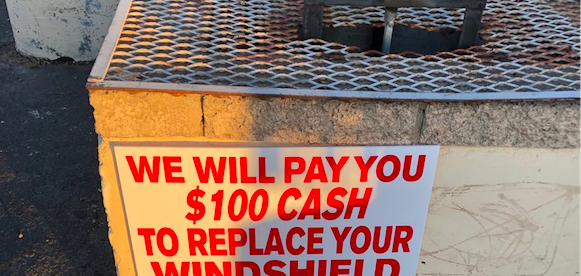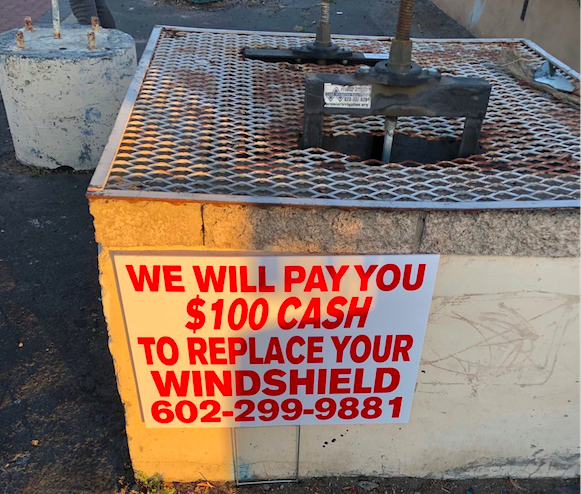A Glass Loophole


The offer made by the sign pictured above is a common one in Arizona, or, at least, more common than you’ll find in most other places. It reads “we will pay you $100 cash to replace your windshield” and it seems too good to be true. You, the owner of a car, get a new windshield and you get $100? How does a business like that possibly exist? What’s the catch?
There is none — unless, maybe, you sell auto insurance.
Arizona law regulates the auto insurance industry in a very narrow, specific way — they have to offer consumers a policy which includes “full glass” coverage. If you have that coverage — and many drivers do — your insurance company can’t charge you a deductible if you get a new windshield in Arizona. Proponents of the law note that Arizona leads the country in windshield repair rates, which they credit to a few factors. High temperatures and dry climates render windshields weaker than they are in other places. And where other states have lush lawns, trees, and other types of vegetation, Arizona has a lot of dust, rocks, and gravel. Combine these two factors and you get a relatively high number of stones flying at weakened windshields — and therefore, a lot of broken glass.
Windshields, though, are made to crack without shattering. That’s for safety reasons — you don’t want a driver showered with glass. But that also means that if your windshield cracks and you want to tempt fate, you can also drive around with a crack or puncture for a while. Of course, sooner or later that’s going to lead to a huge problem, but for those who can’t afford the couple hundred dollars a new windshield typically costs, it may be a risk worth taking. That’s what Arizona saw when they passed the windshield insurance law a few decades ago.
For consumers, that was great — crack your windshield, you get a new one, free. And for auto repair shops and, later, windshield replacement specialty shops, this was a windfall — they still got paid. Consumers could choose where to get their glass replaced based on reputation, convenience, and other non-pecuniary factors — until some of these businesses got an idea. Why not bid for this business with cash? If the insurance company was paying you, say, $350 to replace a windshield, you could afford to give the customer $100 back and still make a profit. So that’s exactly what they did.
Of course, that leads to some pretty questionable incentives. The sign pictured above doesn’t spell it out, but note that there’s no requirement that your windshield be damaged — “we will pay you $100 cash to replace your windshield” sounds like a straightforward offer. That would be insurance fraud on behalf of the repair shop, yes, but it’s probably not one easily discovered. And besides, what’s to prevent the consumer (or even the repair shop!) from firing gravel at a windshield until it cracks? Free money, right? Maybe the reason Arizona has so many windshield repairs is because of their laws, not the other way around?
That’s certainly what insurance companies feared, so they’ve pushed the state government to change the law. By and large, though, that’s been unsuccessful. There’s a law which specifically deals with fraudulent windshield repairs, although according to AZCentral, “nobody has been charged with breaking this law in at least 15 years [as of June 2018]”. And recently, some legislators tried to repeal the law which causes this problem, but that failed. So for the time being, if you need some new glass and want to make a buck, go to Arizona.
Bonus fact: It doesn’t rain often in Arizona — it’s the desert, after all — but when it does, the lack of storm drains means flooding is surprisingly common. So when it floods there, don’t try to drive through a cordoned-off area. Not only will you fail, but it’s going to cost you. If you get stuck, under state law, you will be “liable for the expenses of any emergency response that is required to remove [you or your vehicle] from the public street or highway.” The provision is, colloquially, known as the “stupid motorist law.”
From the Archives: Nothing There. In Arizona, Nothing is something, but it’s still not much.
Photo by Casey Newton.
